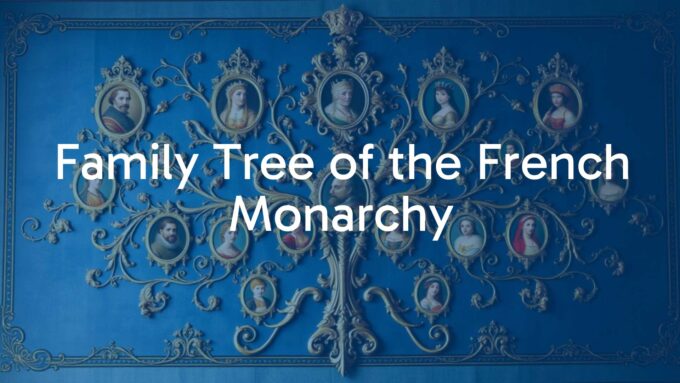French art has a long and varied history, showing a steady change in styles, methods, and ideas for hundreds of years. From ancient cave paintings to modern abstract works, France has been a center of new artistic ideas. The story of its art is not just a series of movements, but a mix of social changes, politics, and individual talent that helped shape art around the world. Each new style grew from or pushed against those that came before, making French art an ongoing story of creativity that is still important today.

The progress of art movements in France closely followed the country’s changing history. Major events like the French Revolution, the rise and fall of powerful rulers, and the founding of art academies over time shifted art styles. The Académie Royale de Peinture et de Sculpture, started in 1648, set the standards for art education and taste. But as the years passed, especially in the 18th and 19th centuries, more artists challenged these rules, searching for freedom in what and how they painted. After the Revolution and the closure of the Académie, artists had more freedom to experiment. New movements came quickly, with each trying to show the world in a fresh way. Art in France changed from the order of the Enlightenment to the emotion of Romanticism to the honesty of Realism-always reflecting the wider social and cultural shifts of their eras.
Timeline of French Art Movements: Key Periods and Changes
How did French art movements develop over time?
If we look at French art in order, it starts with ancient cave paintings at places like Lascaux and Chauvet, showing animals and simple scenes from thousands of years ago. In the Middle Ages, the focus shifted to Romanesque and Gothic styles, seen in impressive cathedrals with detailed carvings and stained glass, like Notre-Dame. The Renaissance brought new interest in classical ideas and portraiture, influenced by Italian masters and local artists like Jean Clouet.
During the 1600s, Classicism and Baroque art flourished, focusing on order and grandeur, especially in the Palace of Versailles. The 1700s saw the soft and decorative Rococo style, soon giving way to the serious lines of Neoclassicism, which matched the mood of the Enlightenment and the Revolution. The 1800s brought great change: from Romanticism’s passion to Realism’s depiction of everyday life. The latter half of the century belonged to Impressionism-famous for its light and color-and then Post-Impressionism, which went deeper into personal expression. The early 1900s introduced Modernism, with bold styles like Fauvism and Cubism breaking old rules about art. Mid-century saw the rise of Dada and Surrealism, exploring dreams and the unconscious. Into the present, movements like Nouveau Réalisme and Figuration Libre showed that French artists continue to experiment and question what art can be.

Which historical moments changed French art?
French art has always reacted to the country’s big events. The French Revolution of 1789 was a major turning point. Before the Revolution, the Académie Royale controlled what was considered good art, favoring work that supported the monarchy. After King Louis XVI fell in 1793, this system broke apart, allowing artists to try new things.
These changing times had a direct effect on art. Neoclassicism used images from ancient Greece and Rome to speak about virtue and justice, while artists like Jacques-Louis David painted scenes that praised or criticized new leaders and social values. As power shifted between different governments in the 1800s, Romanticism showed strong emotions, and Realism focused on the struggles of ordinary people. Industrial growth gave Impressionists new scenes and fast-moving city life to paint. After World War I, movements like Dada and Surrealism questioned reason and logic, influenced by the war’s chaos. In every age, the changing social and political world of France deeply influenced its artists and their work.
Main Early French Art Movements (16th-18th Centuries)
| Movement | Key Dates | Main Features | Notable Artists |
|---|---|---|---|
| School of Fontainebleau | 1530s, 1590s | Mixing Italian Renaissance with French style; elaborate palace decoration | Rosso Fiorentino, Primaticcio, Niccolò dell’Abbate, Dubois, Dubreuil |
| Classicism | 1600s | Order, balance, scenes from history and mythology | Le Brun, Poussin, Mignard, Girardon, Le Nôtre |
| Baroque | 1600s-early 1700s | Grandeur, dramatic scenes but more controlled in France, royal patronage | Le Brun, Mignard, de la Fosse, Coypel, Coysevox, Girardon |
| Rococo | 1700s | Light, playful, decorative, focused on the pleasures of the elite | Watteau, Boucher, Fragonard, Nattier, Oudry, Chardin |
| Neoclassicism | Late 1700s-1800s | Return to ancient ideals, reason, moral duty | David, Ingres |

French Art Movements in the 19th Century
| Movement | Main Ideas | Examples of Artists |
|---|---|---|
| Romanticism | Emotion, imagination, dramatic scenes | Géricault, Delacroix, Corot |
| Realism | Everyday life and people, honest depictions | Courbet, Millet, Daumier |
| Naturalism | Close to Realism, but more focus on how the environment shapes people | Bastien-Lepage, Ribot |
| Barbizon School | Landscapes painted from life, rural scenes | Rousseau, Corot, Dupré, Daubigny, Millet |
| Impressionism | Capturing light, color, everyday scenes, visible brushwork | Monet, Renoir, Degas, Manet, Morisot, Pissarro |
| Post-Impressionism | Personal expression, bold colors, structure, techniques like Pointillism | Cézanne, Gauguin, Seurat, van Gogh, Toulouse-Lautrec |
| Pont-Aven School | Symbolic color, simple forms, rural Brittany | Gauguin, Bernard, Sérusier |
| Symbolism | Meaning through symbols, dreams, myths | Redon, Moreau, Puvis de Chavannes |
| Les Nabis | Flat colors, decorative art, everyday life | Sérusier, Bonnard, Vuillard, Denis, Vallotton |

Modern French Art Movements (20th Century)
| Movement | Key Approach | Main Artists |
|---|---|---|
| Fauvism | Bright, unnatural colors, simple shapes | Matisse, Derain, Vlaminck, Rouault |
| Cubism | Breaking objects into simple forms, showing many sides at once | Picasso, Braque, Léger, Metzinger, Gris |
| Orphism | Abstract color, movement, circles and shapes | Robert Delaunay, Sonia Delaunay, Kupka |
| Purism | Simplicity, clean lines, influence from machines | Ozenfant, Le Corbusier |
| Dada | Randomness, anti-art, protest, collage | Picabia, Arp, Duchamp |
| Surrealism | Dreams, the unconscious mind, unexpected combinations | Breton, Tanguy, Masson, Dalí |
| School of Paris | Mix of many styles; many artists from around the world working in Paris | Chagall, Soutine, Modigliani, Brâncuși |
| Tachism/Art Informel | Abstract, gestures, quick brushwork, focus on the process | Fautrier, Dubuffet, Mathieu, Wols |
French Art Movements after World War II
- Nouveau Réalisme (1960s): Using real-life objects, consumer goods, and torn posters in art. Key artists: Yves Klein, Arman, Niki de Saint Phalle.
- Lettrism (1940s-): Focus on the visual and sound qualities of letters, breaking down language. Key artists: Isidore Isou, Maurice Lemaître.
- Situationist International (1957-): Blending art and politics, creating experiences to challenge how people live and use cities. Key figure: Guy Debord.
- Fluxus (1960s-): Performance, humor, art as part of daily life, not just objects. Key French artists: Robert Filliou, Ben Vautier.
- Figuration Libre (1980s): Colorful, bold, playful art using figures, comics, and graffiti. Key artists: Robert Combas, Hervé Di Rosa.
- French Pop Art (1960s): Like American Pop Art, focused on popular images, advertising, and consumer goods but with a distinct critical edge. Artists: Martial Raysse, Arman.
Notable Artists and Their Roles Across Movements
Who were the main figures in each French art movement?
Certain French artists left a big mark on each movement:
- Fontainebleau: Rosso Fiorentino, Primaticcio, Niccolò dell’Abbate
- Classicism and Baroque: Charles Le Brun, Nicolas Poussin
- Rococo: Jean-Antoine Watteau, François Boucher, Fragonard
- Neoclassicism: Jacques-Louis David
- Romanticism: Géricault, Delacroix
- Realism: Courbet, Millet
- Barbizon School: Rousseau, Corot
- Impressionism: Monet, Renoir, Degas, Manet
- Post-Impressionism: Cézanne, Gauguin, Seurat
- Symbolism: Redon, Moreau
- Les Nabis: Sérusier, Bonnard, Vuillard
- Fauvism: Matisse, Derain
- Cubism: Picasso, Braque
- Orphism: Robert and Sonia Delaunay
- Purism: Ozenfant, Le Corbusier
- Dada: Picabia, Duchamp
- Surrealism: Breton, Tanguy, Masson
- Post-1945: Klein, Arman, Combas, Di Rosa
How did these leaders bring about change?
Artists drove change by questioning the rules before them. David used art to comment on politics and morality during Neoclassicism. Delacroix made color and emotion central in Romanticism, an idea that would shape how art looked for generations. Courbet made paintings of real people and moments, paving the way for Impressionism and modern art. Monet and the Impressionists focused on how we see the world, painting quick impressions from direct observation. Cézanne turned natural forms into basic shapes, helping to start Cubism. Duchamp pushed the idea that ordinary objects could be art just by being chosen by an artist. Matisse used color boldly, turning it into a main focus of art. Picasso and Braque broke up objects to show many sides at once. In the second half of the 20th century, artists like Yves Klein, by experimenting with materials and performance, helped inspire movements like performance art. France became an important place for new ideas because these artists kept testing boundaries.

French Art Movements: Key Works and Landmarks
What famous artworks represent these movements?
- Prehistoric: Chauvet and Lascaux cave paintings
- Medieval: Bayeux Tapestry, Chartres Cathedral stained glass
- Renaissance: Clouet’s “Portrait of François I”
- Classicism: Poussin’s “The Abduction of the Sabine Women”
- Rococo: Fragonard’s “The Swing”
- Neoclassicism: David’s “Oath of the Horatii,” “The Death of Marat”
- Romanticism: Géricault’s “The Raft of the Medusa,” Delacroix’s “Liberty Leading the People”
- Realism: Courbet’s “A Burial at Ornans,” “The Origin of the World”
- Impressionism: Monet’s “Impression, Sunrise,” Renoir’s “Le Moulin de la Galette”
- Post-Impressionism: Seurat’s “A Sunday on La Grande Jatte,” Gauguin’s Tahitian works, van Gogh’s expressive paintings
- Modern Sculpture: Rodin’s “The Kiss”
- Fauvism: Matisse’s “Woman with a Hat”
- Cubism: Picasso’s “Les Demoiselles d’Avignon,” Braque’s “Compotier et verre”
- Dada/Conceptual: Duchamp’s “Fountain”
- Nouveau Réalisme: Yves Klein’s “Anthropometries of the Blue Period”
- Contemporary: Louise Bourgeois’s “Maman”
How did architecture and the decorative arts matter?
Buildings and craft arts (like furniture and glass) often set the mood for these periods. Gothic cathedrals such as Notre-Dame combined sculpture, stained glass, and design to make powerful spaces. In the Renaissance, places like Fontainebleau were decorated with elaborate murals and furniture, blending Italian trends with French skill. The Palace of Versailles is a good example from the Baroque era, showing how architecture, gardens, and interior design worked together for royal display. Rococo saw a turn to smaller spaces and more delicate decoration in the homes of the wealthy. Neoclassical buildings like the Arc de Triomphe went back to simple lines and ancient themes. Later, Art Nouveau made everyday objects and even subway stations (like Guimard’s Paris Métro entrances) works of art with curving, plant-like designs. Throughout, architecture and decorative crafts both reflected and helped set the style of painting and sculpture in France.
How French Art Movements Influenced the World
How did French movements spark changes in other countries?
Artists around the world watched French art for new ideas. During the Court of Louis XIV, the order and form of French Classicism were copied in palaces across Europe. Rococo’s sweet style showed up in German and British decoration. In the 1800s and 1900s, the new styles that started in France-like Impressionism, Post-Impressionism, and Cubism-changed the way artists everywhere painted. American, Russian, and Australian painters learned from French Impressionism, while Cézanne’s structured approach led to Cubism and inspired abstract artists everywhere. Surrealism spread far beyond France into Latin America, Asia, and America, affecting not just art but books, movies, and design.
Which movements had the strongest impact globally?
- Impressionism: Inspired similar movements worldwide, from the US to Australia.
- Post-Impressionism: Cézanne’s methods led directly to many 20th-century styles; Pointillism, Symbolism, and expressive color travelled widely.
- Cubism: Changed how artists everywhere thought about space and form, leading to abstract art.
- Surrealism: Influenced painting, writing, film, and more in many countries.
These movements made France a key source of new ideas in art, and their influence is still seen in art schools, museums, and creative work around the globe today.













Leave a comment